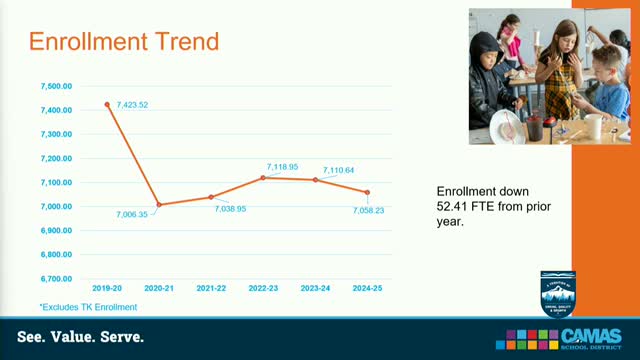Business services reports FY24-25 closeout: fund balance down, capital reserves concentrated in impact fees
October 27, 2025 | Camas School District, School Districts, Washington
This article was created by AI summarizing key points discussed. AI makes mistakes, so for full details and context, please refer to the video of the full meeting. Please report any errors so we can fix them. Report an error »

Kim, director of business services, presented the district's fiscal closeout for fiscal year 2024-25 at the Oct. 22 board meeting, reporting revenue, expenditures and fund-balance trends.
Kim said the district recorded approximately $124 million in revenue for the year, with 77 percent from the state, 15 percent from local taxes and 3 percent from federal sources. Expenditures totaled about $127.5 million, with roughly 75 percent directed to teaching and learning. The district's ending general fund balance was reported at about $7.3 million and has continued a downward trend from previously recommended policy targets.
Kim highlighted several details: a decline of about 52.4 FTE during the prior year (with running start and alternate learning included in broader FTE calculations), significant pressure from special education costs and capital-project balances held largely in impact fees. The capital projects fund balance was listed at about $19 million, much of it in impact fees that are tied to growth-related capital uses. The district's debt-service fund balance was about $8 million, and transportation vehicle funds were roughly $2.3 million.
Board members asked for public-facing opportunities to view business-services work; Kim said the department is running transparent “nerding out with the fiscal team” sessions both in person and by Zoom and will share invites with the board.
Kim warned that state revenue outlooks were uncertain and that the district would continue a cost-containment approach while monitoring enrollment and other revenue drivers.
Kim said the district recorded approximately $124 million in revenue for the year, with 77 percent from the state, 15 percent from local taxes and 3 percent from federal sources. Expenditures totaled about $127.5 million, with roughly 75 percent directed to teaching and learning. The district's ending general fund balance was reported at about $7.3 million and has continued a downward trend from previously recommended policy targets.
Kim highlighted several details: a decline of about 52.4 FTE during the prior year (with running start and alternate learning included in broader FTE calculations), significant pressure from special education costs and capital-project balances held largely in impact fees. The capital projects fund balance was listed at about $19 million, much of it in impact fees that are tied to growth-related capital uses. The district's debt-service fund balance was about $8 million, and transportation vehicle funds were roughly $2.3 million.
Board members asked for public-facing opportunities to view business-services work; Kim said the department is running transparent “nerding out with the fiscal team” sessions both in person and by Zoom and will share invites with the board.
Kim warned that state revenue outlooks were uncertain and that the district would continue a cost-containment approach while monitoring enrollment and other revenue drivers.
View the Full Meeting & All Its Details
This article offers just a summary. Unlock complete video, transcripts, and insights as a Founder Member.
✓
Watch full, unedited meeting videos
✓
Search every word spoken in unlimited transcripts
✓
AI summaries & real-time alerts (all government levels)
✓
Permanent access to expanding government content
30-day money-back guarantee

